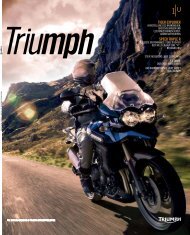Angels - PageSuite
Angels - PageSuite
Angels - PageSuite
You also want an ePaper? Increase the reach of your titles
YUMPU automatically turns print PDFs into web optimized ePapers that Google loves.
AMAZONAS<br />
76<br />
Above, left to right: If<br />
the opponent doesn’t<br />
swim away, but spreads<br />
his fins, then the dance<br />
begins. Here a large<br />
old male is challenging<br />
a young tank-bred male<br />
with orange-tipped<br />
pectoral fins. The older<br />
these fishes get, the<br />
longer the first rays of<br />
the first dorsal fin grow.<br />
Adversaries typically<br />
carry the dorsal and<br />
ventral fins stiffly<br />
extended. Initially<br />
they remain at a short<br />
distance; as hostilities<br />
progress they come<br />
closer together and<br />
use laterally directed<br />
movements to send<br />
little waves of water<br />
toward each other.<br />
These two are near<br />
the end of their battle.<br />
They have come<br />
very close together<br />
and the younger fish<br />
(foreground) is about<br />
to give up. It is unclear<br />
why, but all disputes<br />
end in this way and the<br />
loser is not harmed.<br />
territories. Females swimming into these little territories are not courted by dancing, but<br />
approached from the front with gentle head nodding. If the female doesn’t swim away, the<br />
courting male turns next to her, quivering briefly. They swim beside each other in the direction<br />
of a spawning substrate—in my tanks this is a mop or a clump of Java Moss. This spawning<br />
procedure can be seen every day; the entire group is constantly ready to spawn if well fed.<br />
I collect the eggs regularly and incubate them in a bowl in shallow water. The eggs are around<br />
the same size as those of other small blue-eyes, such as Pseudomugil gertrudae—about 1.2 mm<br />
in diameter.<br />
Not at all difficult<br />
Unfortunately, not all the eggs developed in my tap water, which had a temperature of 77–<br />
80°F (25–27°C), a pH of 7.5, and an electrical conductivity of around 350 μS/cm. I assume<br />
that the species actually inhabits the swamps in the drainage of the Kopi, and thus lives in<br />
very soft black water with a low bacteria count. In the case of eggs transferred to 100 percent<br />
reverse-osmosis water, the larvae hatch after 10 to 12 days without problems. If I hatch them<br />
in bowls filled with tap water, I have to help at hatching time (Evers, 2011).<br />
I feed the adults daily with Artemia nauplii, live or frozen Cyclops and water fleas, and very<br />
occasionally with very high-protein granulate. The frequent feeding of such granulate and<br />
Artemia nauplii isn’t healthy for the fish. Like other small species of blue-eyes, the females, in<br />
particular, become misshapen and fat if their diet is too rich. Their bellies become distended<br />
and they must be put on a strict diet or you will lose them. Feeding them entirely on pond




